


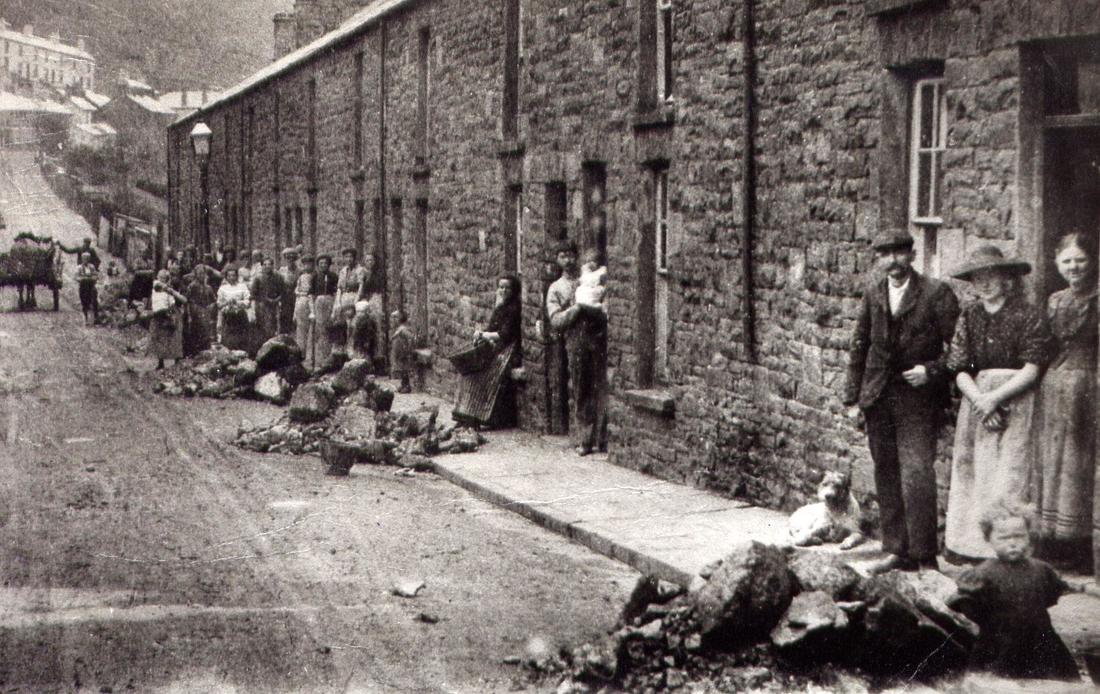
The Industrial Revolution brought about many changes to how people worked, which impacted how those same people lived. More and more people moved away from rural areas to the cities in search of work, and the lack of legal protections meant many people lived in poverty and filth. But the Industrial Revolution also brought people more opportunity to buy consumer goods or take part in leisure activities. To learn more about the living conditions during this time, read through the resources provided below.
This website contains a brief description of some of the living conditions experienced by people during the Industrial Revolution and the health effects of these conditions. It includes a photo album with a number of primary source photographs and illustrations.
This article from History Crunch looks at how the Industrial Revolution impacted the standard or living for British people, and what the living conditions in industrial towns were like.
Conditions varied from the splendor and opulence of the homes of the wealthy to the squalor of the lives of the workers. The Industrial Age saw new homes for the rich mimicking stately homes, whilst those for the poor were often ramshackle, dirty slum dwellings. This article describes the different kinds of homes available during the Industrial Revolution.
This article looks at the impact that the Industrial Revolution had on the standards of living for poor and middle classes in Europe. It examines why different historians have different opinions on the living conditions of the time period, and includes a resource list for further reading.
With a clear distinction drawn between upper, middle and working classes, life in the Industrial Era varied according to who you were and where you lived. This website from the BBC looks at different aspects of everyday life from health to housing to entertainment. It includes lots of dot point summaries and images.
One important impact of the industrial revolution (such as the use of coal, iron, and steam) was rapid urbanization, as new and expanding industry caused villages and towns to swell, sometimes into vast cities. As a result, these towns became hotbeds of disease and depredation, prompting a debate in Britain about public health. This article looks at how poor living conditions impacted the health of people during the Industrial Revolution.


Extracts from the Second Report of Commissioners of Inquiry into the State of Large Towns and Populous. Districts, 1842, [published in 1844]
This Report built on the work of Edwin Chadwick’s earlier ’Inquiry into the Sanitary Conditions of the Labouring Population of Great Britain’, 1842, into the urban health of 50 of the largest towns. It directly related disease to poor living conditions. The Health of Towns Association, a political pressure group formed in 1844 also campaigned to improve sanitary conditions in towns and cities. It strongly supported the creation of local Boards of Health that were obliged to appoint an Inspector of Nuisances. The Association was key in putting pressure on the government to pass the Public Health Act in 1848.
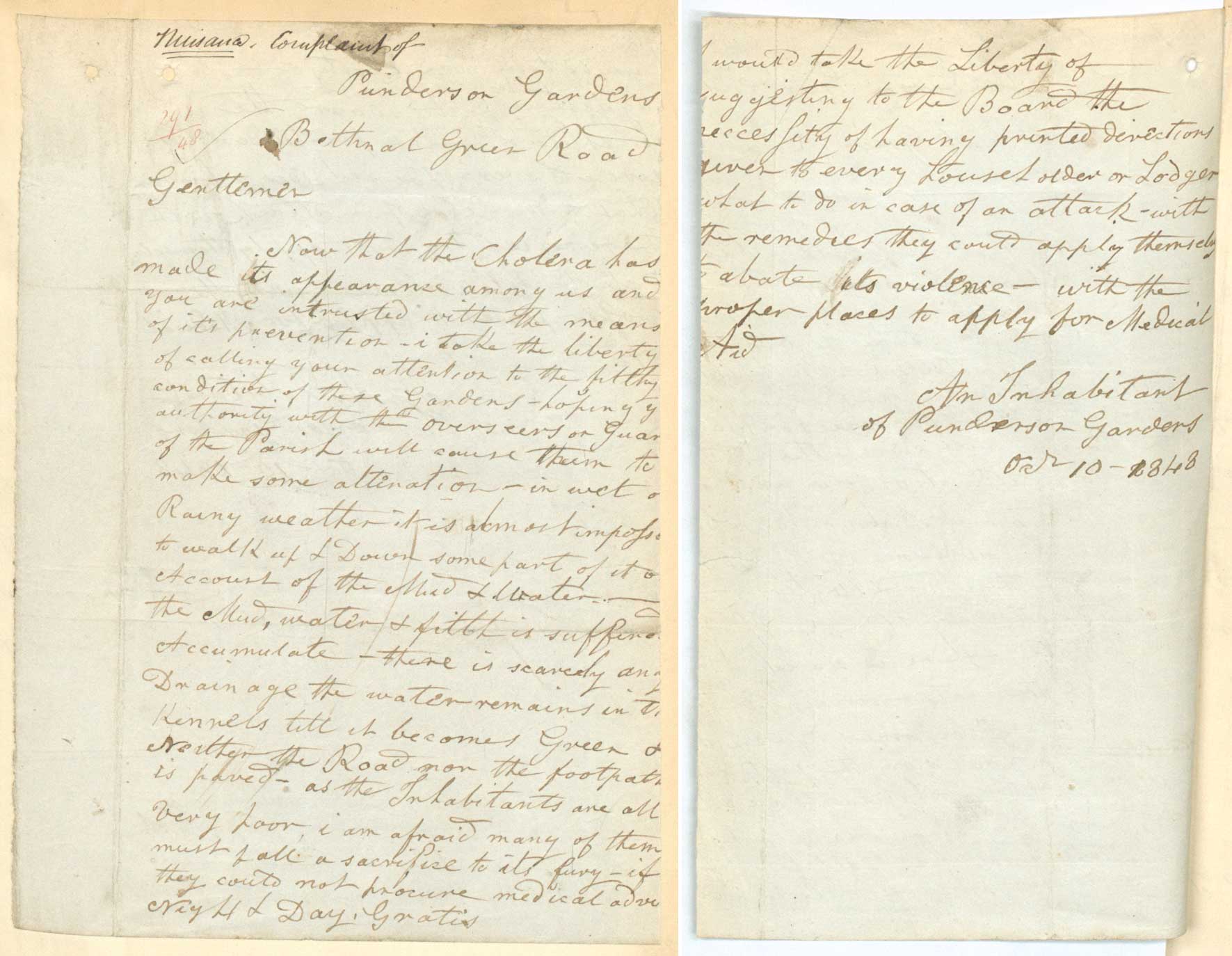
A ‘nuisance letter’ to the General Board of Health requesting it to force parish authorities to resolve the ‘nuisance’ of filthy gardens in Bethnal Green, 10 October 1848
Nuisance complaint
Punderson Gardens
Bethnal Green Road
Gentlemen
Now that the cholera has made its appearance among us and you are intrusted with the means of its prevention, I take the liberty of calling your attention to the filthy condition of these gardens- hoping [your] authority with the overseers or [Guardians] of the Parish will cause them to make some attention. In wet rainy weather it is almost impossible to walk up and down some part of it on account of the Mud and water. The Mud, water and filth is suffered [to] Accumulate- there is scarcely any Drainage. The water remains in kinnels [channels?] till it becomes Green and Neither the Road nor the footpath is paved as the Inhabitants are all very poor. I am afraid many of them must fall a sacrifice to its fury [die from cholera]-if they could not procure [get] medical advice night and day gratis [free].
I would take the liberty of suggesting to the Board the necessity of having printed directions given to every house owner or lodger what to do in case of an attack with the remedy they could apply themselves to abate its violence-with the proper places to apply for medical Aid.
An inhabitant of Punderson Gardens
October 10, 1848
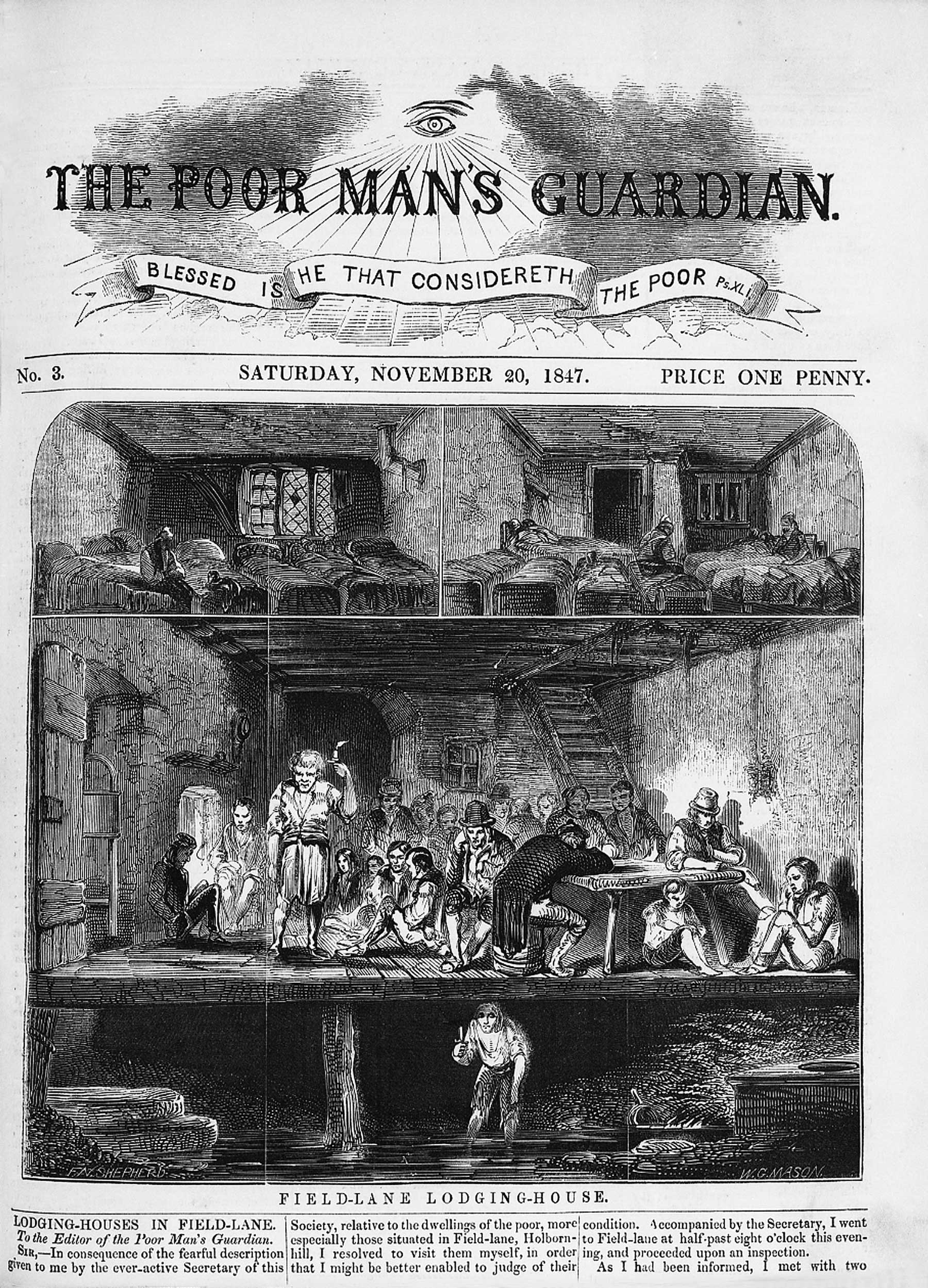
Extract from the ‘Poor Man’s Guardian’ newspaper, 20 November 1847
‘The Poor Man’s Guardian’ was an early working class newspaper and the voice of The Poor Man’s Guardian Society, an organisation devoted to exposing neglect or cruelty towards the poor. The Society was founded in response to the Poor Law Amendment Act of 1834.
This illustration was accompanied by an article written by Charles Cochrane, the chairman of the Poor Man’s Guardian Society, about the lives of the poor who lived in lodging houses in Field Lane, Clerkenwell in London. Charles Dickens probably used Field Lane in his novel ‘Oliver Twist’ as the location for Fagin’s hideout with his gang of child pickpockets.
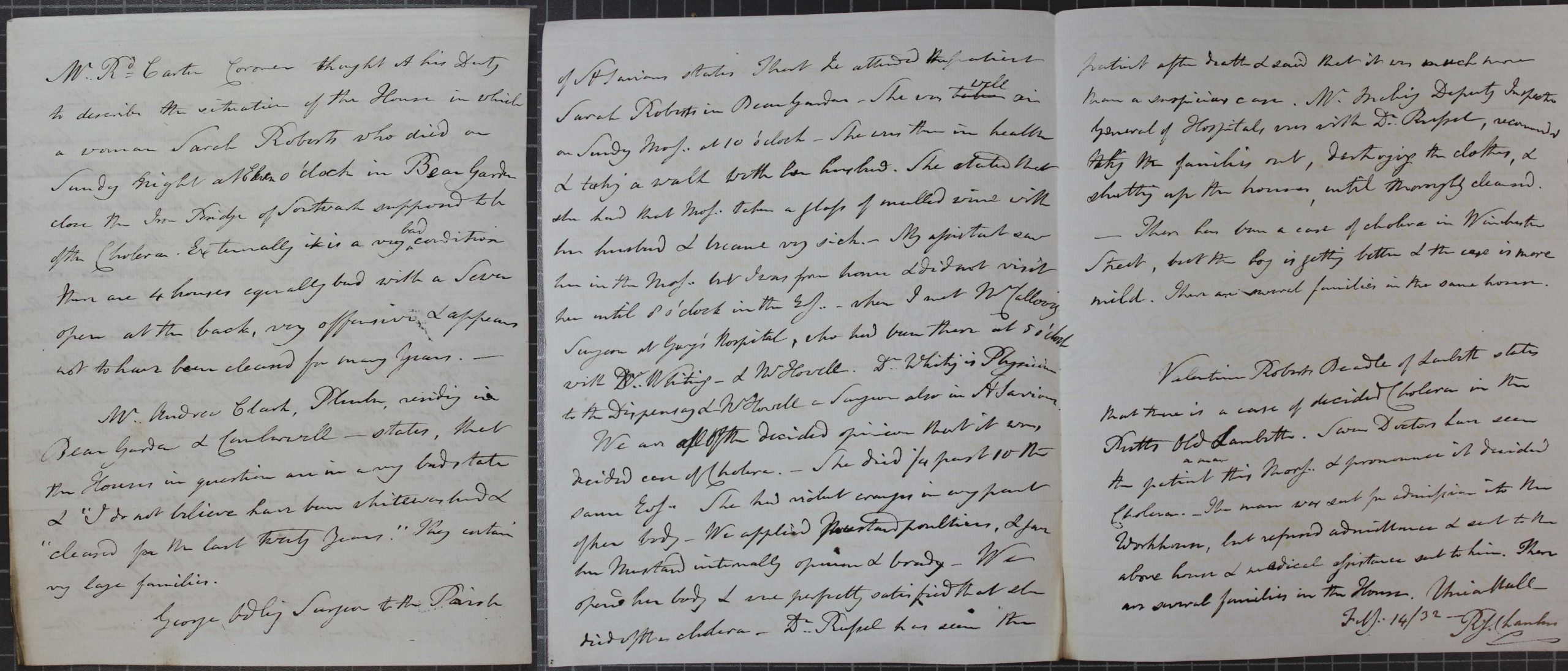
An example of a cholera case which came before the coroner in Southwark and was reported to the Board of Health. It linked poor housing to the disease, 14 February 1832.
Mr Richard Carter, Coroner thought it his duty to describe the situation of the House in which a woman Sarah Roberts who died on Sunday Night at Eleven o’clock in Bear Gardens close from Iron Bridge of Southwark supposed to be of the Cholera. Externally it is a very bad condition, there are four houses, equally bad with a sewer open at the back, very offensive and appears not to have been cleaned for many years.
Mr. Andrew Clark, plumber residing in Bear Gardens & Camberwell-states that the houses in question are in a very bad state and “I do not believe have been whitewashed and cleaned for the last twenty years”. They contain large families.
George Bedly Surgeon to the Parish of St. Saviours’ states that he attended the patient Sarah Roberts in Bear Gardens, She was well on Sunday morning. At 10 o’ clock she was then in health and taking a walk with her husband. She stated that she had that morning taken a glass of mulled wine with her husband and became very sick. My assistant saw her in the morning but I was from home and did not visit her until 8’o clock in the evening. When I met Mr Mallory, Surgeon at Guy’s hospital, who had been there at 5 o’ clock with Dr Whiting and Mr Howell. Dr Whiting is Physician to the Dispensary & Mr Howell is Surgeon also in St. Saviour’s.
We are all of the decided opinion that it was decided case of Cholera. She died ¼ past 10 the same evening. She had violent cramps in every part of her body. We applied mustard poultices [mustard paste spread on cloth] and gave her mustard internally opium and brandy. We opened her body and were perfectly satisfied that she died of the cholera. Dr Russel has seen the patient after death and said that it was much more than a suspicious case. Mr Miling Deputy Inspector General of Hospitals was with Dr Russel recommended taking the families out, destroying the clothes and shutting up the houses until thoroughly cleansed.
There has been a case of cholera in Winchester Street, but the boy is getting better and the case is [milder]. There are several families in the same house.
Valentine Roberts, Beadle [parish official] of Lambeth states that there is a case of decided Cholera in the Butts Old Lambeth. Seven Doctors have seen the patient, a man this morning and pronounce it decided cholera. The man was sent for admission into the Workhouse, but refused admittance and sent to the above house and medical assistance sent to him. There are several families in the house…
February 14 1832 R.J. Chambers
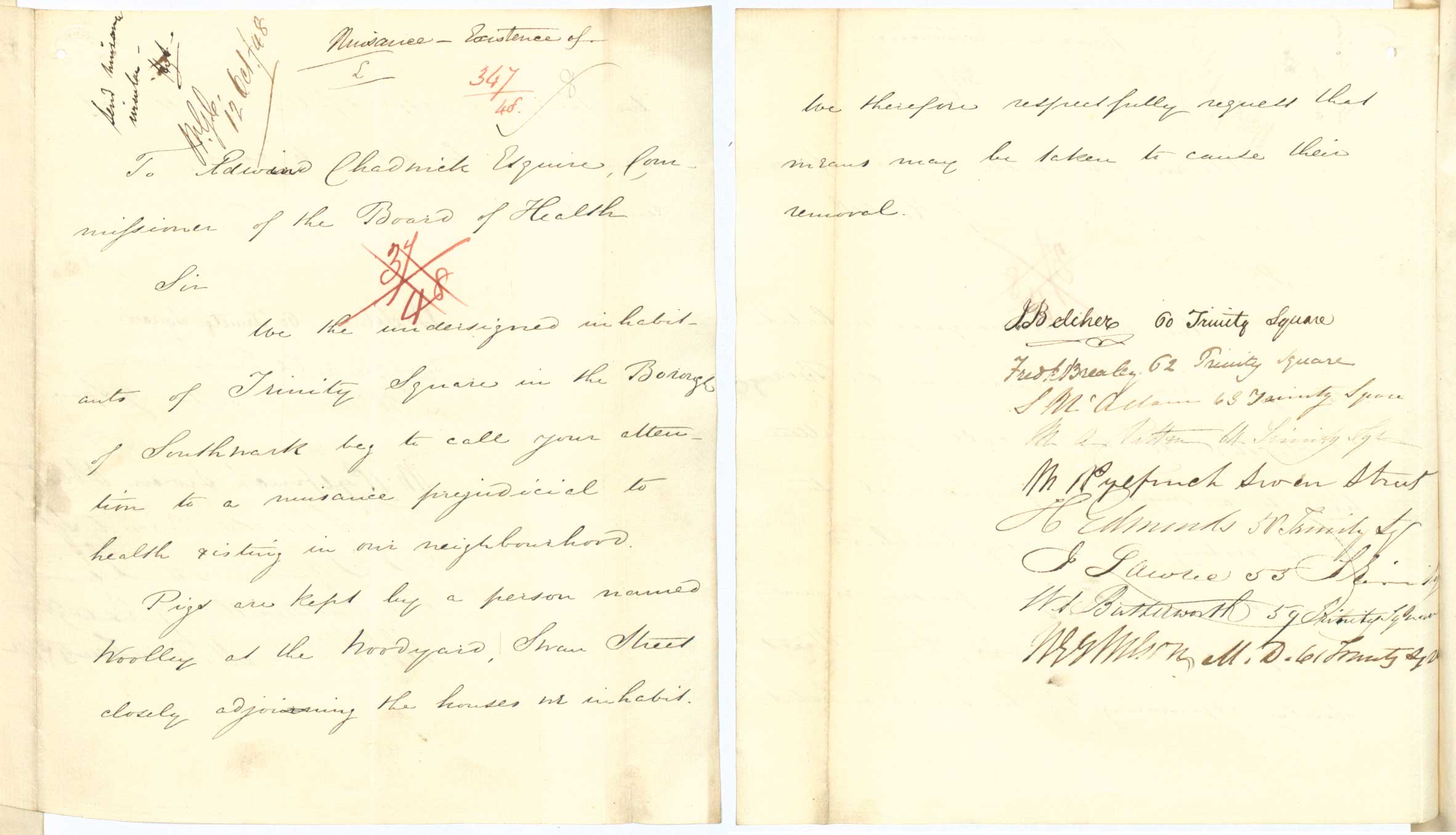
A ‘nuisance letter’ to Edwin Chadwick at the General Board of Health concerning pigs kept in Trinity Square, Southwark, 12 October 1848.
12th October 1848
To Edwin Chadwick Esquire, Commissioner of the Board of Health
We the undersigned inhabitants of Trinity Square in the Borough of Southwark beg to call your attention to a nuisance prejudicial to health existing in our neighbourhood.
Pigs are kept by a person named Woolley at Hoodyard, Swan Street closely adjoining the houses we inhabit.
We therefore respectfully request that means may be taken to cause their removal.
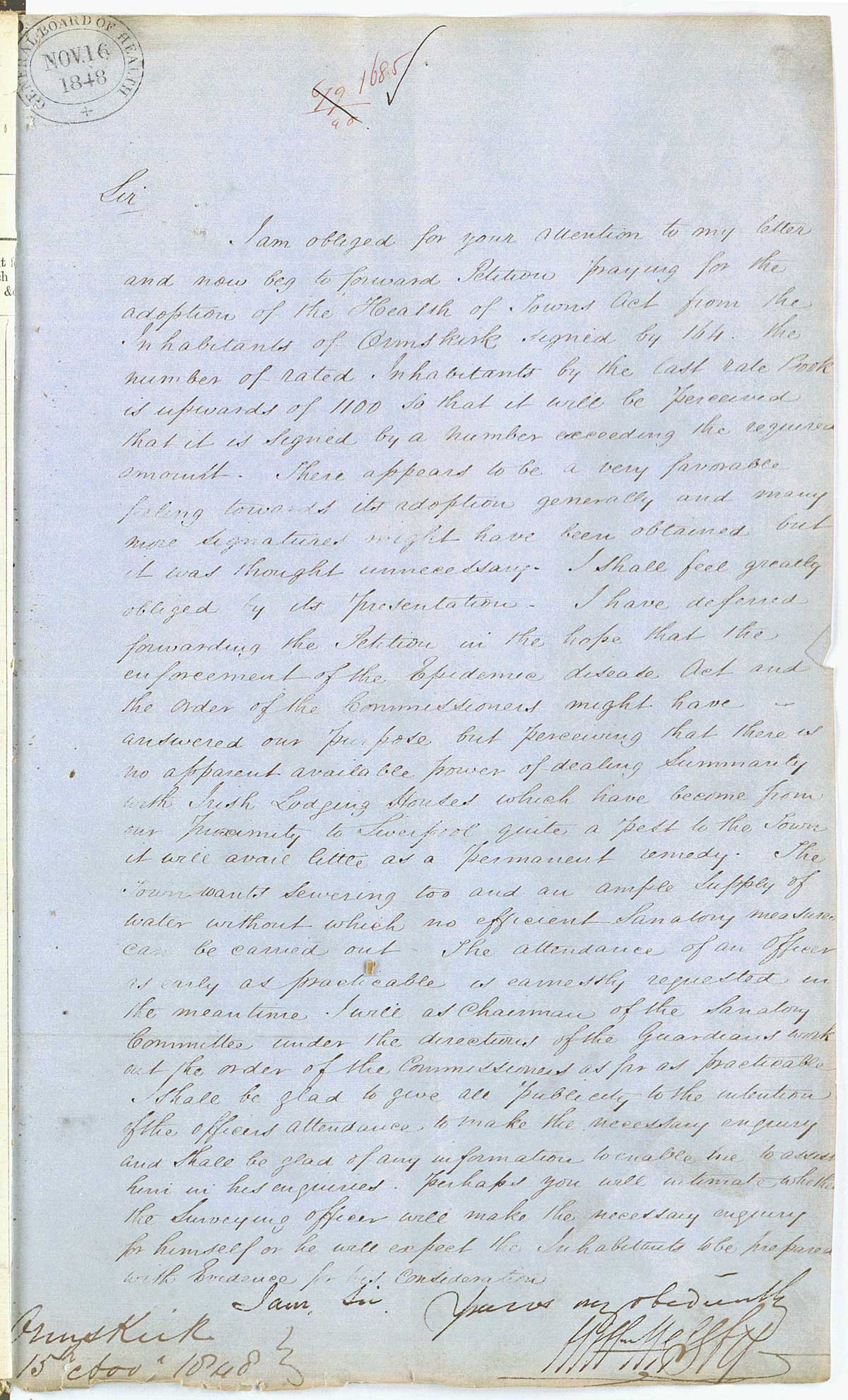
A letter from the Chairman of the Sanitary Committee of Ormskirk in Lancashire to the General Board of Health to request that it set up a Local Board of Health, 15 October, 1848.
After such a request, the General Board of Health sent an inspector to look at the sanitary condition of the town. At least ten percent of the ratepayers had to sign a petition to request their own board. We have included in this collection a subsequent petition from local towns’ people in Ormskirk contesting the need for a local board.
Sir
I am obliged for your attention to my letter and now beg to forward Petition praying for the adoption of the Health of Towns Act from the Inhabitants of Ormskirk signed by 164.The number of rated Inhabitants by the Cast rate Book is upwards of 1100 so that it will be perceived that it is signed by a number exceeding the required amount. There appears to be a very favourable feeling towards its adoption generally and many more signatures might have been obtained but it was thought unnecessary. I shall feel greatly obliged by its presentation. I have deferred forwarding the Petition in the hope that the enforcement of the Epidemic disease Act and the Order of the Commissioners might have answered our purpose but perceiving that there is no apparent available power of dealing Summarily with Irish Lodging Houses which have become from our proximity to Liverpool quite a pest to the town it will avail little as a permanent remedy.
The town wants sewering too and an ample supply of water without which no efficient sanitary measures can be carried out. The attendance of an officer as early as practical is earnestly requested in the meantime. I will as Chairman of the Sanitary Committee under the directions of the Guardians work out the order of the Commissioners as far as practicable shall be glad to give all publicity to the intention of the officers’ attendance to make the necessary inquiry and shall be glad of any information to enable me to assess him his inquiries. Perhaps you will intimate whether the surveying officer will make the necessary inquiries for himself or he will expect the inhabitants to be prepared with evidence for his consideration.
I am, Sir, Yours very obediently,
Ormskirk, 15th October, 1848
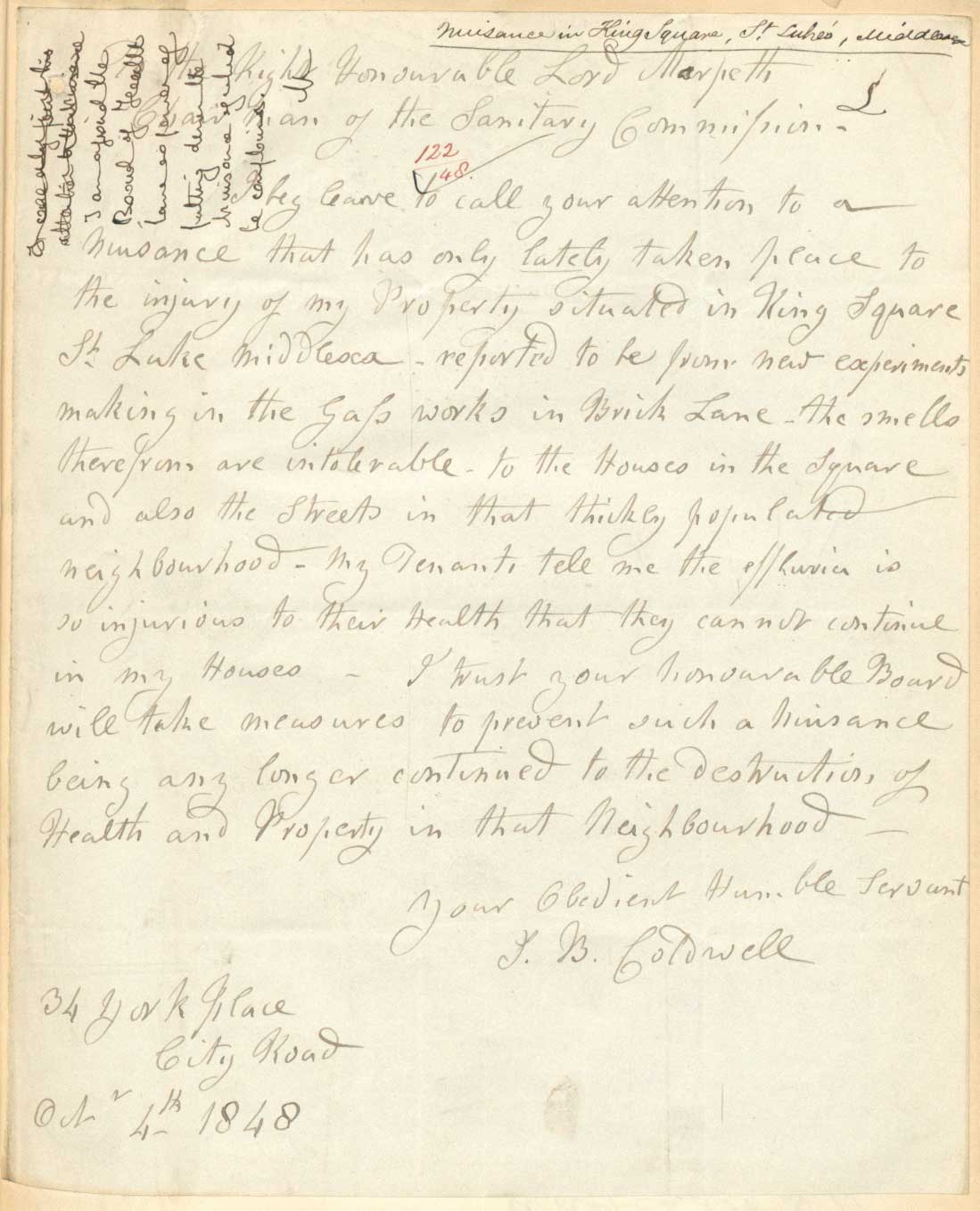
A ‘nuisance letter’ to Lord Morpeth, Chairman of the Sanitary Commission about the nuisance of a gasworks in King’s Square, St. Luke’s, Middlesex, 4 October 1848.
[The clerk’s note at the top left of the letter says that the Board of Health has no power to deal with this nuisance]
Nuisance in Kings Square, St Luke’s, Middlesex
To the Right Honourable Lord Morpeth Chairman of the Sanitary Commission
I beg leave to call your attention to a nuisance that has only lately taken place to the injury of my property situated in King Square, St. Luke’s, Middlesex, reported to be from new experiments making in the Gasworks in Brick Lane. The smells there from are intolerable to the houses in the square and also the streets in that thickly populated neighbourhood. My tenants tell me the effluvia [bad odour] is so injurious [damaging] to their health that they cannot continue in my houses. I trust your Honourable Board will take measures to prevent such a nuisance being any longer continued to the destruction of health and property in that neighbourhood.
Your Obedient Humble Servant,
T.B. Coldwell
34 York Place
City Road
October 4th 1848
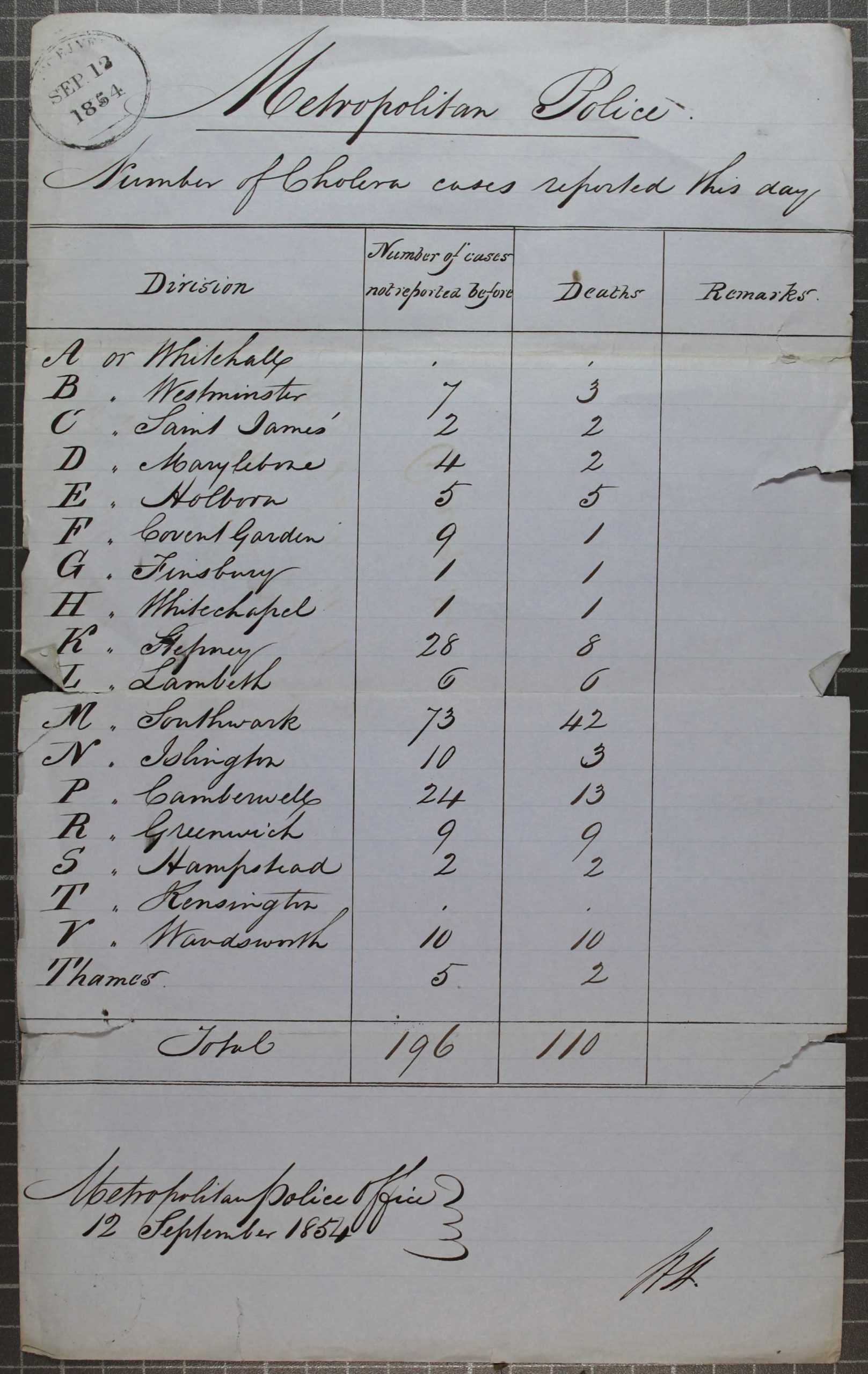
Deaths from cholera reported for London by the Metropolitan Police, 12th September, 1854, Catalogue ref: HO 45
Metropolitan Police
Number of cholera cases reported this day
| Division | Number of cases not reported before | Deaths | Remarks |
| A or Whitehall | – | – | – |
| B. Westminster | 7 | 3 | |
| C. Saint James | 2 | 2 | |
| D. Marylebone | 4 | 2 | |
| E. Holborn | 5 | 5 | |
| F. Covent Garden | 9 | 1 | |
| G. Finsbury | 1 | 1 | |
| H. Whitechapel | 1 | 1 | |
| K. Stepney | 28 | 8 | |
| L. Lambeth | 6 | 6 | |
| M. Southwark | 73 | 42 | |
| N. Islington | 10 | 3 | |
| P. Camberwell | 24 | 13 | |
| R. Greenwich | 9 | 9 | |
| S. Hampstead | 2 | 2 | |
| T. Kensington | – | – | |
| V. Wandsworth | 10 | 10 | |
| Thames | 5 | 2 | |
| Total | 196 | 110 |
Metropolitan Police Office
12 September 1854
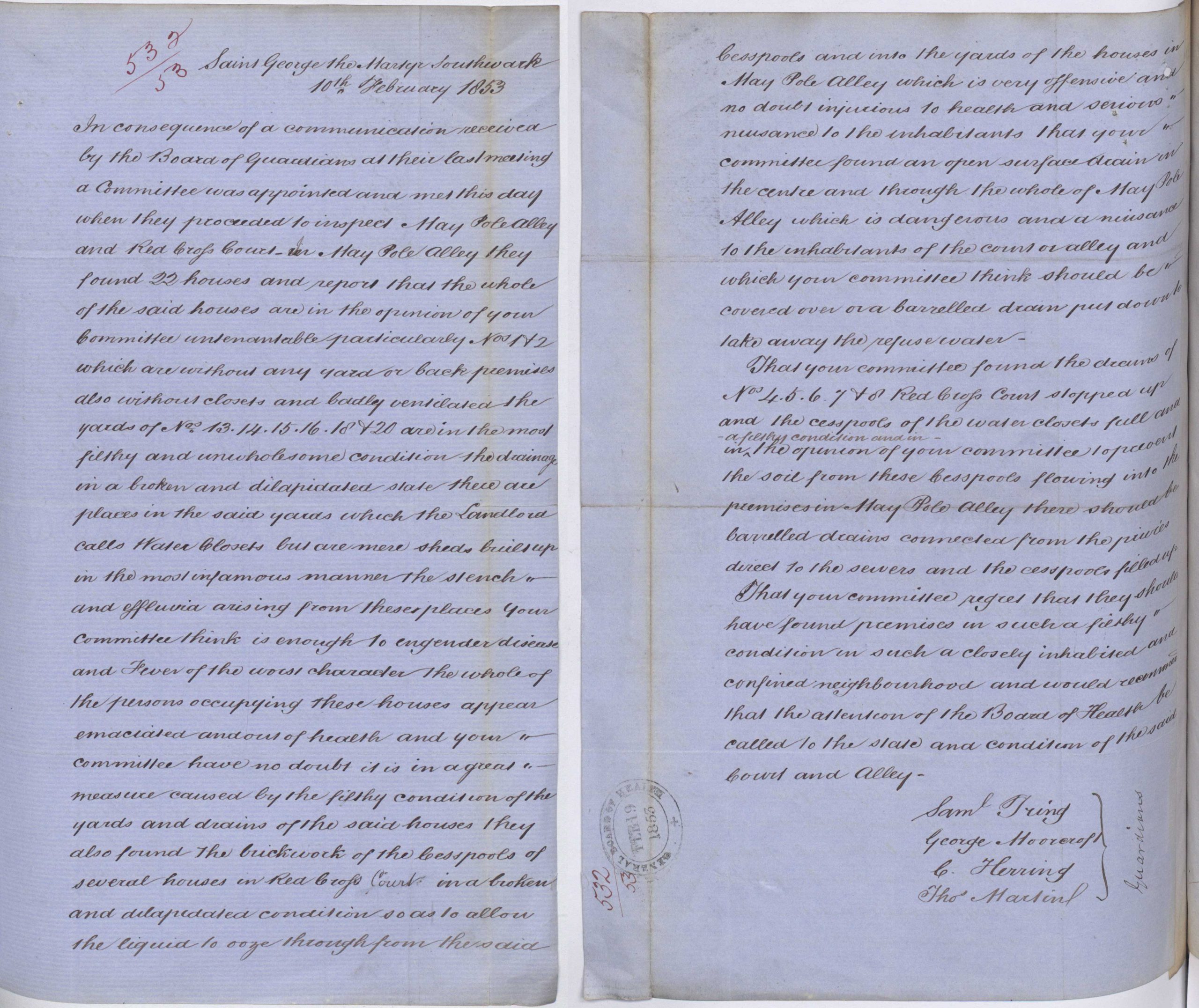
Extract from a report sent to the General Board of Health initiated by the Board of Guardians concerning housing in Red Cross Alley and May Pole Alley, Parish of St George the Martyr in Southwark, London, 17 February 1855, Catalogue ref: MH 13/261.
Saint George the Martyr, Southwark
10th February 1853
In consequence of a communication received by the Board of Guardians at their last meeting, a committee was appointed, and met this day when they proceeded to inspect May Pole Alley and Red Cross Court. In May Pole Alley they found 22 houses and report that the whole of the said houses are in the opinion of your committee un-tenantable, particularly Nos. 1 & 2 which are without any yard or back premises, also without closets and badly ventilated. The yards of Nos. 13, 14, 15, 16, 18 & 20 are in the most filthy and unwholesome condition, the drainage in a broken and dilapidated state, there are places in the said yards which the landlords call water closets, but these are mere sheds built up in the most infamous manner. The stench and effluvia [foul smell] arising from these places, your committee think is enough to engender disease and fever of the worst character, the whole of the persons occupying these houses appear emaciated [thin] and out of health and your committee have no doubt it is in a great measure caused by the filthy condition of the yards and drains of the said houses.
They also found the brickwork of the cesspools of several houses in Red Cross Court in a broken and dilapidated condition so as to allow the liquid to ooze through from the said cesspools and into the yards of the houses in May Pole Alley which is very offensive and no doubts injurious to health and serious nuisance to the inhabitants, that your committee found an open surface drain in the centre and through the whole of May Pole Alley which is dangerous and a nuisance to the inhabitants of the court or alley and which your committee think should be covered over or a barrelled drain put down to take away the refuse water.
That your committee found the drains of Nos. 4.5.6.7 & 8 Red Cross Court stopped up and the cesspools of the water closets full and in a filthy condition and in the opinion of your committee to prevent the soil from these cesspools flowing into the premises in May Pole Alley there should be barrelled drains connected from the privies direct to the sewers and the cesspools filled up.
That you committee regret that they should have found premises in such a filthy condition in such a closely inhabited and confined neighbourhood and would recommend that the attention of the Board of Health be called to the state and condition of the said court and alley.
Samuel Tring )
George Moorcroft ) Guardians
C. Herring )
Thomas Martin )
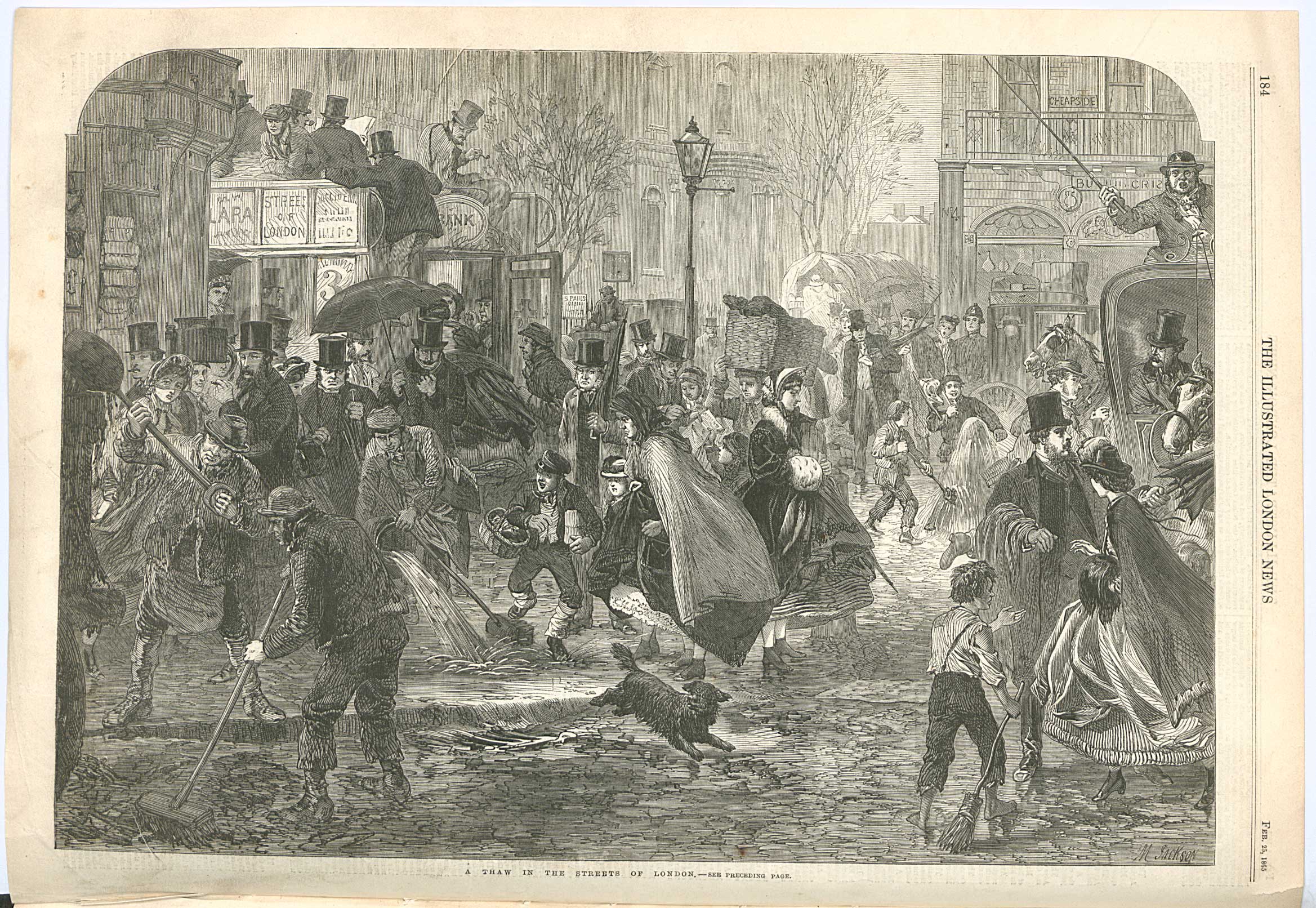
Illustration from the Illustrated London News entitled ‘London Street scene in the thaw’, 1865.
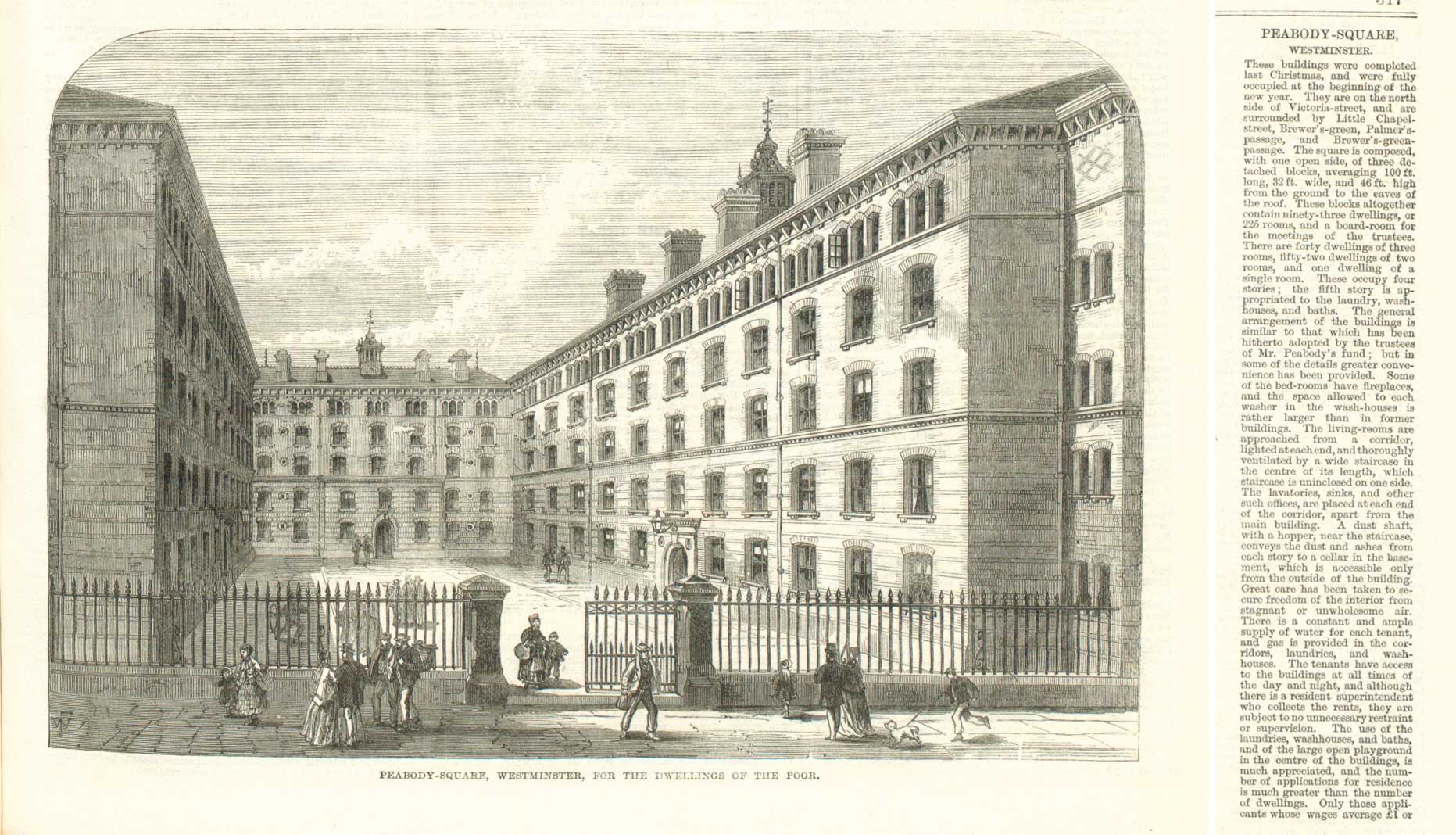
An extract from an article, with an illustration, concerning Peabody housing from the Illustrated London News, 27 March, 1869.
George Peabody 1795-1869 was an American business man and philanthropist. He set up the Peabody Donation Fund in 1862 and built the first homes for the labouring poor in Commercial Street in Spitalfields in 1864. This source is an example of further funded buildings in Peabody Square, Westminster. Three blocks housed 93 low-rent flats with separate wash houses, baths and laundries. There was also a playground for children.
PEABODY-SQUARE WESTMINSTER
These buildings were completed last Christmas, and were fully occupied at the beginning of the New Year. They are on the north side of Victoria Street, and are surrounded by Little Chapel street, Brewer’s-green, Palmer’s passage, and the Brewer’s-green passage. The square is composed, with one open side, of three detached blocks, averaging 100 square feet long, 32 ft. wide, and 46ft. high from the ground to the eaves of the roof. These blocks altogether contain ninety-three dwellings, or 225 rooms, and a boardroom for the meeting of the trustees. There are forty dwellings of three rooms, fifty-two dwellings of two rooms, and one dwelling of a single room. These occupy four stories, the fifth story is appropriated to the laundry, wash-houses, and baths. The general arrangement of the buildings is similar to that which has been hitherto adopted by the trustees of Mr. Peabody’s fund; but in some of the details greater convenience has been provided. Some of the bedrooms have fireplaces and the space allowed to each washer in the wash-houses is rather larger than in former buildings. The living-rooms are approached from a corridor, lighted at each end, and thoroughly ventilated by a wide central staircase in the centre of its length, which staircase is unenclosed on one side. The lavatories, sinks, and other such offices, are placed at each end of the corridor, apart from the main building. A dust shaft, with a hopper, near the staircase, conveys the dust and ashes from each story to a cellar in the basement, which is accessible only from the outside of the building. Great care has been taken to secure freedom of the interior from stagnant or unwholesome air. There is a constant and ample supply of water for each tenant, and gas is provided in the corridors, laundries and wash-houses. The tenants have access to the buildings at all times of the day and night, and although there is a resident superintendent who collects the rents, they are subject to no unnecessary restraint or supervision. The use of the laundries, washhouses, and baths, and of the large open playground in the centre of the buildings, is much appreciated, and the number of applications for residence is much greater than the number of dwellings
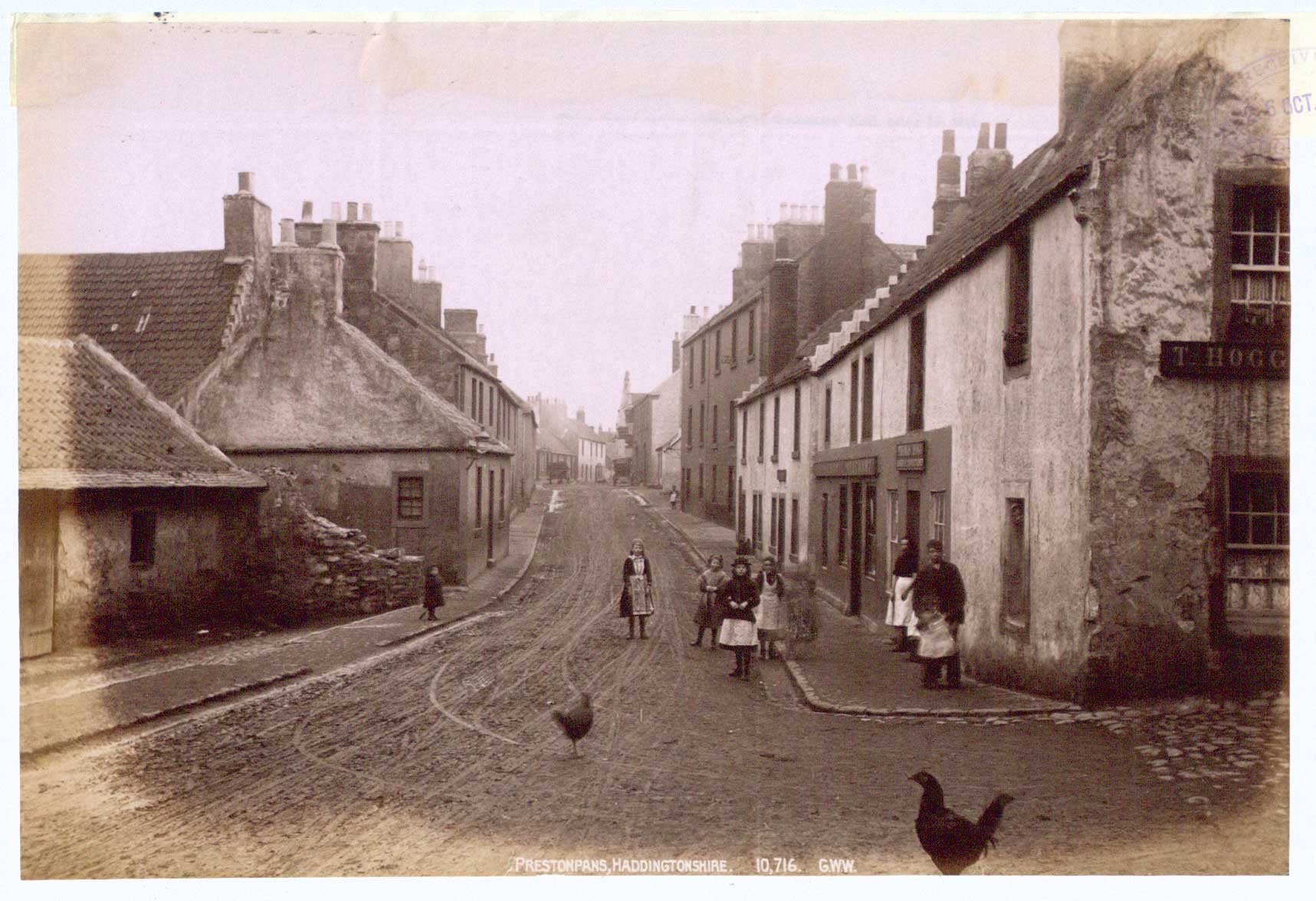
Photograph of a street with chickens in Prestonpans, Haddingtonshire (East Lothian), Scotland, 1898.

Written by Charles Cochrane, the chairman of the Poor Man’s Guardian Society, this is a vivid account of lives lived in poverty on the outskirts of the City of London. In the basement of one lodging house, for instance, he finds:
amongst other offensive matter which arrested our attention … dead cats, in a semi-putrescent state. We were, however, assured by the parties connected with this horrid establishment, that the filth and dead animals referred to, were thrown into the cellar from the street and were frequently being removed by the dustmen. As I proceeded to question them more closely on these points, I found their answers so unsatisfactory, that I doubt very much if the dustmen pay them many visits during the year.
Cochrane visits another house and discovers that one man is renting the whole place for 11 shillings a week, but sub-letting its five makeshift bedrooms for 30 shillings a week.
The lodging houses described here are all on Field Lane in Clerkenwell, then an industrial district just to the north of the City. Largely the home of the labouring classes, it was notorious for its poverty, crime and overcrowding. In 1843, Charles Dickens visited the Field Lane ‘ragged school’ (an independent charitable school for the poorest children in the area) and was so disgusted and moved by the poverty he saw that he became a patron of the school. He had already used Field Lane in his fiction, however: it’s the location of Fagin’s den of child pickpockets in Oliver Twist (1838).

The Rookeries of London is a mid-19th-century report that explores the typical living conditions in London's 'rookeries'. It was written by Thomas Beames, a clergyman who was driven to investigate the subject after witnessing dire living conditions and extreme poverty within inner-city London. Beames draws on his own eye-witness accounts of rookeries and argues that one’s environment has a direct impact on education, lifestyle, and crime.
Towards its end, Beames reveals the book's main purpose: to call for a parliament Act to 'remedy' the problems he has witnessed.
‘Rookery’ is a 19th-century term for the densely populated, low-quality housing found within slum areas. They were overcrowded, scantily equipped, poorly ventilated, and unhygienic. Many families lived within a small, single room. By squeezing dozens of people within one building, corrupt landlords gained high financial returns.
Beames describes three of London’s most notorious rookeries – St Giles, Saffron Hill and Bermondsey. He writes, 'A dirtier or more wretched place he had never seen. The street was very narrow and muddy, and the air was impregnated with filthy odours'.
